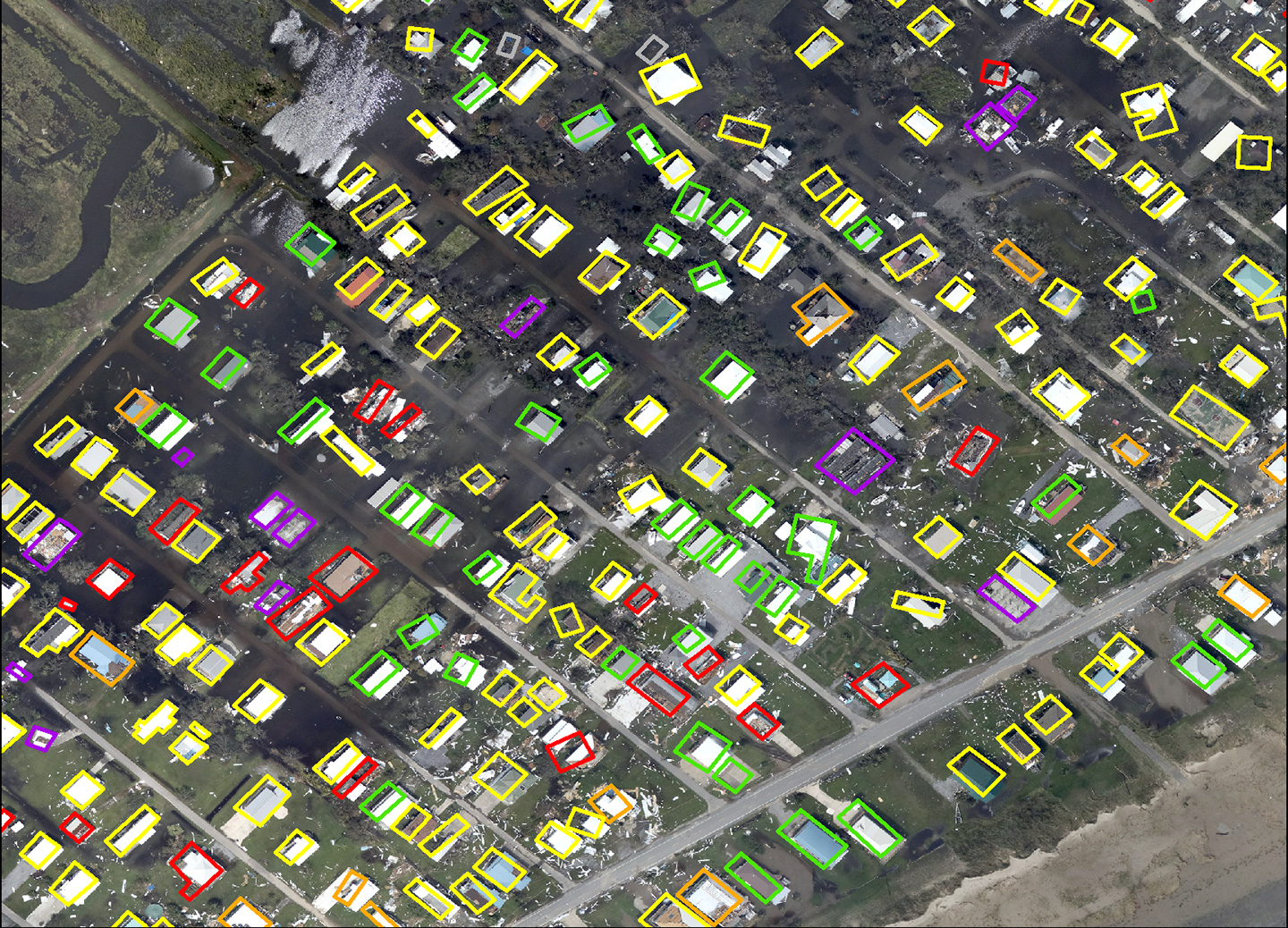In February 2018, we shared a video explaining geospatial damage assessments and how the information can be used to expedite recovery from disaster events. At the time, our geospatial damage assessments were created using modeled impact data, such as flood depth inundation models and visual review of post-event imagery. Traditionally, each analyst was able to perform 100 visual damage assessments an hour, enabling federal, state, and local emergency managers to make critical decisions for resource and funding allocation to communities in need. We are constantly looking for ways to provide emergency managers higher quality and quicker geospatial damage assessments to help more rapid informed decisions.
This year, we incorporated machine learning methods into our geospatial damage assessment process, which resulted in an ability to perform over 410,000 automated damage assessments in a single hour. While machine learning has dramatically increased the speed of damage assessments, it does require certain types of data. This blog discusses some of these data types and highlights the value of developing a data management plan so they are available when needed.
This year, we incorporated machine learning methods into our geospatial damage assessment process, which resulted in an ability to perform over 410,000 automated damage assessments in a single hour. ”
Catherine Bohn
Using Geospatial Damage Assessment Data
Geospatial damage assessments categorize severity of damage to structures in a disaster area by integrating geospatial and event-specific data. The output data from this process typically consists of geospatial data layers with individual structure features attributed with detailed damage information. Decision-makers use this information to perform the following activities:
- Prioritize where to send field teams
- Identify areas to collect post-event imagery
- Identify shelter locations
- Determine the need, quantity, and distribution location of commodities, such as potable water
- Estimate debris impacts
- Expedite assistance to disaster survivors
- Identify mitigation projects
 Dewberry’s automated machine learning tools expedite geospatial damage assessments using post-event imagery and building footprint data.
Dewberry’s automated machine learning tools expedite geospatial damage assessments using post-event imagery and building footprint data.
Optimizing Through Machine Learning
Our ability to train a computer to identify damages depicted in post-event imagery and associate the damage categories with specific buildings within minutes of the imagery becoming available is now a reality. This year, we completed development, training, and implementation of our machine learning model following Hurricane Ida. We developed a large repository of training data covering multiple previous disaster events in different geographical locations so that our model was not only accurate, but also sufficiently generalized to be applicable to future disaster events. Our initial priority was wind events, so we reviewed historical hurricane and tornado imagery collected by multiple federal agencies and defined a standardized damage classification schema that represented our model outputs following training. Then, our data science team developed damage assessments by manually reviewing the historical imagery. Once the training data set was complete, we trained the model in preparation for the next disaster event, which happened to be Hurricane Ida. Following Hurricane Ida’s landfall in Louisiana, we used our machine learning model to assess over 410,000 structures in 1.6TB worth of National Oceanic and Atmospheric Administration and Civil Air Patrol imagery. We performed thorough quality control on our model outputs. Following this event, we continue to develop and incorporate training data, and we are adding functionality and enhancements, such as identifying non-structure damages (e.g., power lines, roads, bridges) and other disaster event types.
Developing a Data Management Plan
Our machine learning model requires multiple data sources to perform optimally. Our team needs to have a well-defined data management plan to make sure we are using the best available data and any data cleansing, transformation, or other manipulation is performed efficiently. Data management not only feeds our machine learning model, but is also a critical preparedness activity that impacts all aspects of emergency management. We recommend that local jurisdictions develop a data management plan for a variety of reasons, including to:
- Understand what data exists
- Decide whether the data is current and accurate
- Figure out where the data is stored and how it can be accessed and shared
- Streamline many aspects of emergency management
Geospatial data, facility management data, financial and accounting data, and imagery are all critical data types during response and recovery operations. For example, post-event imagery is critical for situational awareness and analytics, so we recommend including a post-event imagery collection, acquisition, and analytics plan as part of your overall data management plan. Building footprints are another great example. Do you have a building footprint dataset for all structures in your community? If so, are your building footprints up-to-date to account for new development? Do you have attribution on your building footprints such as elevation of the first floor to better understand potential flood impacts when storm-related flooding occurs? As you go through the development of your data management plan, you will most likely identify other data that needs creating, updating, or additional attribution to be more useful.
Developing and implementing a data management plan can help your community be better prepared for the next event, facilitate more efficient response and recovery, and enable you to leverage cutting-edge technology, including machine learning derived geospatial damage assessments.